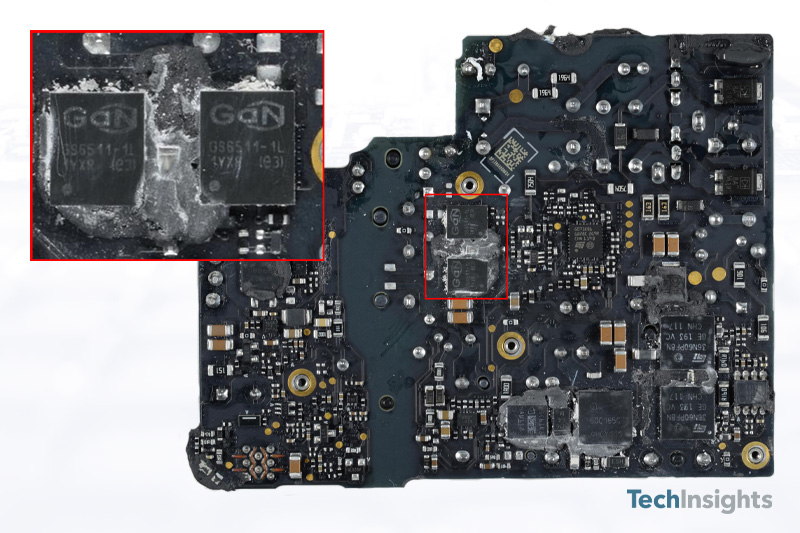Apple's First GaN Charger

Stephen Russell
October 28, 2021
It has been heavily rumoured and anticipated for a few years now, but we have finally seen Apple make the switch to using gallium nitride (GaN) as the power transistor in one of their charging products. The 140 W charger for the new 16-inch MacBook Pro. As has been the case with many innovations in the past, Apple may not be the first, but when they do adopt a technology people take notice!
At TechInsights we have been tracking GaN in USB chargers over the last few years. We originally saw third party aftermarket vendors adopt GaN in their products such as Aukey, RavPower and Hyper Juice with powers ranging from 24 – 100 W. Over the last year however we have begun to see tier one vendors include GaN in-box with both phones and laptops such as Dell, LG and Lenovo.

GaN Systems Gets the Design Win
This is clearly a fantastic design win for GaN Systems. This is a product that was already gaining significant traction within the market. We additionally found the same die from within this product present within ST Microlectronics’ ‘MasterGaN 1’ integrated power stage.
Our Power Semiconductor Subject Matter Experts agree that as well as laptop/mobile charging products this GaN technology could potentially be found in applications such as:
- Data Centre SMPS based on half-bridge topologies including Totem pole PFC
- Light industrial products e.g. motor drives
- Renewable energy e.g. solar inverters
- Automotive e.g. on-board charger (OBC)
- Class D Audio Amplifiers
TechInsights has Analysis Planned for This Device and Cutting-Edge GaN Technology. Stay informed on all of our latest findings…
Preliminary Analysis and Product Specifications
Why has Apple decided to move now and why this product? It is generally accepted at power levels of around 60 W the benefit of GaN can really be seen and it begins to have a clear advantage over conventional silicon products. This is not a strict rule, we have seen Si in chargers right up to 100 W (it is assumed Apples 96 W charger still uses Si) also we have seen GaN present in chargers as low as 24 W. As with all power electronics there is a cost vs. efficiency, size and weight trade-off.
With this being over a 50% increase in Apple’s until now highest power charger of 96 W it seems the necessity is finally here. It will be fascinating to see how Apple further integrates GaN in their products and how the rest of the market reacts.
Although not first to market in its use of GaN Apple are among the first to use the new USB power delivery 3.1 standard (USB PD 3.1). What is this and why does it matter?
- USB 1.0 was the original standard that allowed power transfer over a USB cable up to 100 W at specific voltages/currents and hence power profiles.
- USB 2.0 required USB-C connectors. It allowed multiple voltages and currents giving a continuum of supported power profiles from 0.5 W to 100 W
- USB 3.0 utilized advanced USB-C capabilities such as role swapping where power can be transferred in either direction for example away from phone/laptop as well as to it without changing cables/ports.
- USB 3.1 allows higher voltages (28 V, 36 V and 48 V) providing maximum power of 240 W.
The use of the USB PD 3.1 allowing the large power present in this charger.
References
- 140W USB-C Power Adapter (Apple Website) 2021.
- GaN Systems GS-065-011-1-L 650 V Enhancement Mode GaN Transistor Power Floorplan Analysis (PFR-2011-801) TechInsights, 2021.
- STMicroelectronics MASTERGAN1 600 V Half-Bridge Driver with Two e-Mode GaN EMT Power Essentials Summary (PEF-2010-801) TechInsights, 2021.










